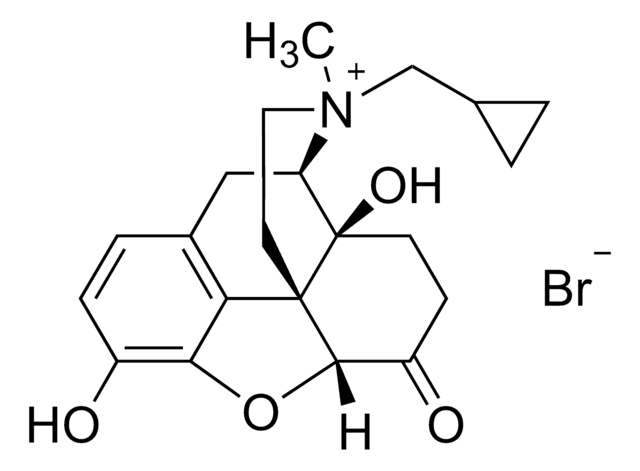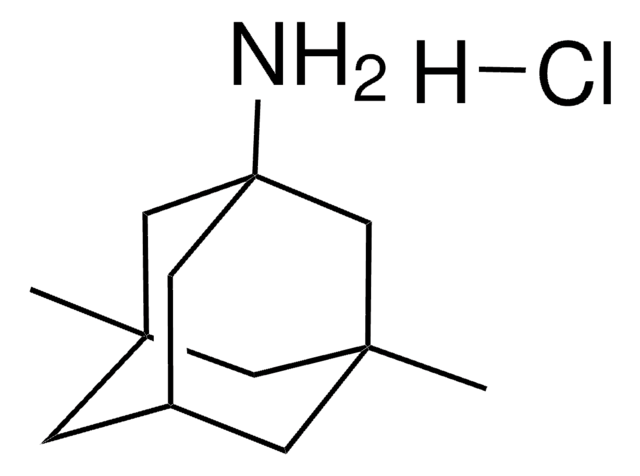SML0277
甲基纳曲酮 溴化物
≥97% (HPLC)
别名:
17-(Cyclopropylmethyl)-4,5α-epoxy-3,14-dihydroxy-17-methyl-6-oxomorphinanium bromide, MNTX, Methylnaltrexonium, Mrz-2663, N-Methylnaltrexone, Naltrexone MB, Quaternary ammonium naltrexone
登录查看公司和协议定价
所有图片(1)
About This Item
经验公式(希尔记法):
C21H26NO4 · Br
CAS号:
分子量:
436.34
MDL號碼:
分類程式碼代碼:
12352200
PubChem物質ID:
NACRES:
NA.77
推荐产品
化驗
≥97% (HPLC)
形狀
powder
儲存條件
desiccated
顏色
white to beige
溶解度
H2O: ≥5 mg/mL
運輸包裝
wet ice
儲存溫度
−20°C
SMILES 字串
[Br-].C[N@+]1(CC[C@]23[C@H]4Oc5c(O)ccc(C[C@@H]1[C@]2(O)CCC4=O)c35)CC6CC6
InChI
1S/C21H25NO4.BrH/c1-22(11-12-2-3-12)9-8-20-17-13-4-5-14(23)18(17)26-19(20)15(24)6-7-21(20,25)16(22)10-13;/h4-5,12,16,19,25H,2-3,6-11H2,1H3;1H/t16-,19+,20+,21-,22?;/m1./s1
InChI 密鑰
IFGIYSGOEZJNBE-KNLJMPJLSA-N
基因資訊
human ... OPRM1(4988)
正在寻找类似产品? 访问 产品对比指南
一般說明
Methylnaltrexone does not cross blood brain barrier and does not affect the opioid effects in the brain, such as analgesia. It is used to treat opioid-induced constipation (OIC).
應用
Methylnaltrexone bromide has been used as a drug to measure plasma protein binding (PPB), permeability (Pm) and the membrane coefficient (KIAM) for the prediction of blood brain barrier (BBB) penetration. It is also used as a mu-opioid receptor (MOR) antagonist to abrogate morphine tolerance and opioid-induced hyperalgesia (OIH).
生化/生理作用
Methylnaltrexone bromide is a narcotic antagonist. It is a peripheral mu-opiod receptor antagonist that cannot cross the blood-brain barrier. It reverses many opioid side-effects without interfering with pain relief.
特點和優勢
This compound is featured on the Opioid Receptors page of the Handbook of Receptor Classification and Signal Transduction. To browse other handbook pages, click here.
訊號詞
Warning
危險聲明
危險分類
STOT SE 2 Oral
標靶器官
Gastrointestinal tract
儲存類別代碼
11 - Combustible Solids
水污染物質分類(WGK)
WGK 3
閃點(°F)
Not applicable
閃點(°C)
Not applicable
Methylnaltrexone for treatment of opioid-induced constipation in advanced illness patients.
Slatkin N, et al.
The Journal of Supportive Oncology, 7(1), 39-46 (2009)
L Garten et al.
Archives of disease in childhood. Fetal and neonatal edition, 97(2), F151-F153 (2011-10-29)
Methylnaltrexone, a peripherally acting µ-opioid receptor antagonist, has been studied in adults for the treatment of opioid-induced constipation in advanced illness. Here, the authors document the first neonate to receive methylnaltrexone in an attempt to resolve morphine-induced urinary retention. An
Danial E Baker
Reviews in gastroenterological disorders, 9(3), E84-E93 (2009-11-10)
Constipation is a common problem associated with opiates and opioid compounds used for the treatment of pain and other medical conditions, and can influence patient quality of life. Methylnaltrexone appears effective in the therapy of opioid-induced constipation and will be
Sergio B Sawh et al.
Mayo Clinic proceedings, 87(3), 255-259 (2012-03-06)
Gastrointestinal dysmotility and constipation are common problems in critical care patients. The majority of critical care patients are treated with opioids, which inhibit gastrointestinal (GI) motility and lead to adverse outcomes. We reasoned that methylnaltrexone (MNTX), a peripheral opioid antagonist
Edward Michna et al.
Pain medicine (Malden, Mass.), 12(8), 1223-1230 (2011-08-04)
Methylnaltrexone, a selective peripherally acting mu-opioid receptor antagonist, effectively treats opioid-induced constipation (OIC) in patients with advanced illness and shows efficacy in patients with chronic nonmalignant pain. The objective was to identify patients who achieved maximal treatment effect based on
我们的科学家团队拥有各种研究领域经验,包括生命科学、材料科学、化学合成、色谱、分析及许多其他领域.
联系技术服务部门








